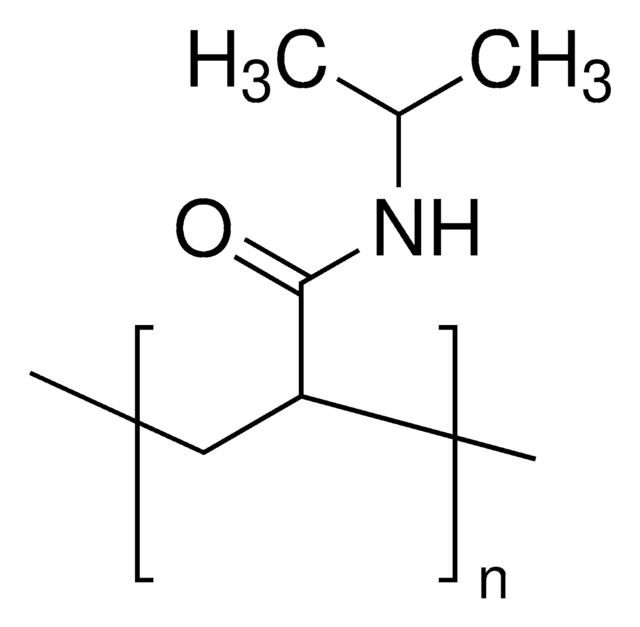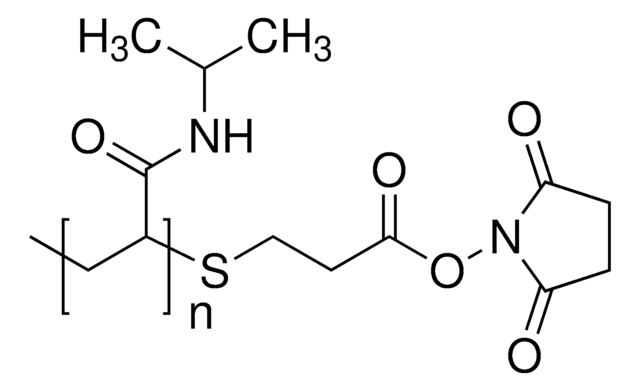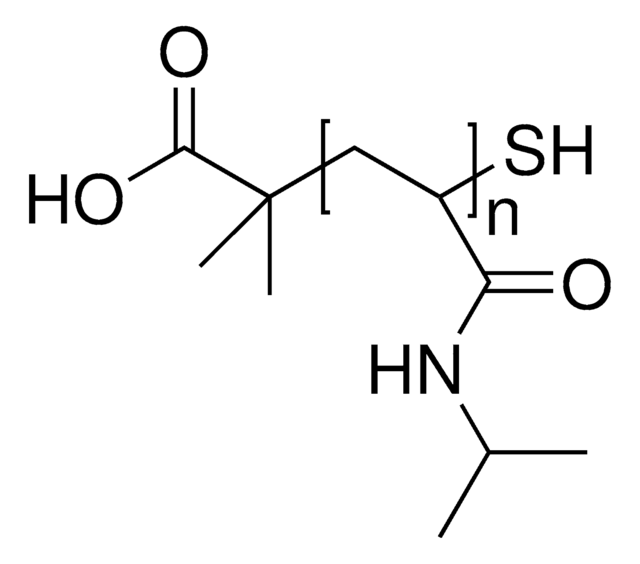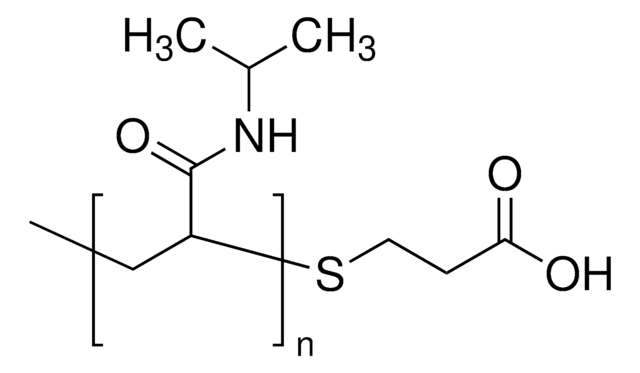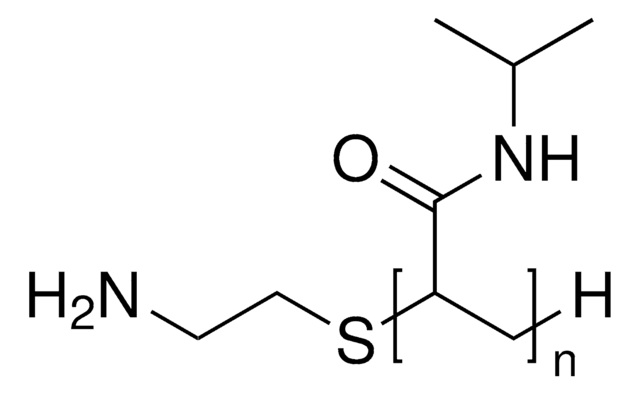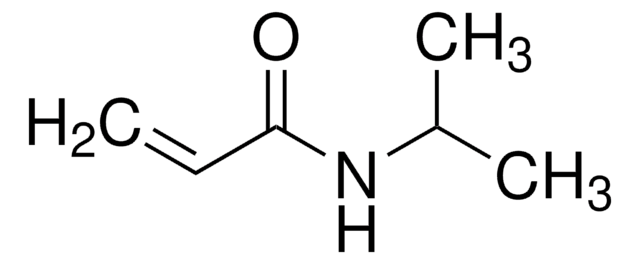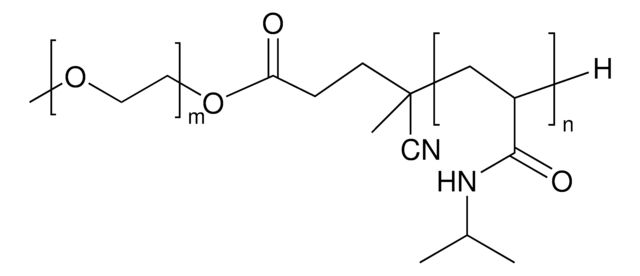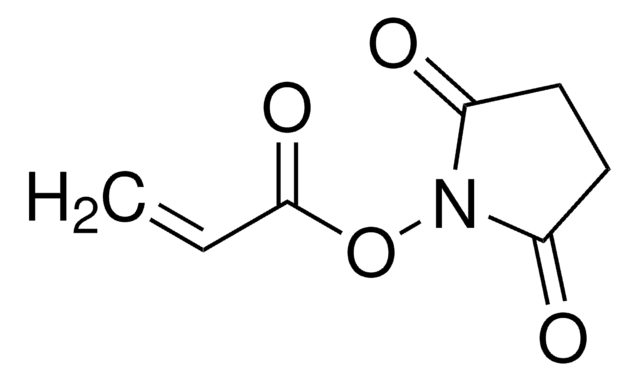900188
Poly(N-isopropyl acrylamide)
NHS ester end functionalized, average Mn 5,000
Synonym(s):
PNIPAM, polyNIPAM
Sign Into View Organizational & Contract Pricing
All Photos(2)
About This Item
Linear Formula:
C8H10NO4(C6H11NO)nH
UNSPSC Code:
12162002
NACRES:
NA.23
Recommended Products
Application
Poly(N-isopropyl acrylamide) (PolyNIPAM) is a stimuli-responsive polymer. This product features low polydispersity (PDI), which typically leads to better reproducibility in applications, and a terminal N-hydroxysuccinimide (NHS) functional group, allowing for rapid conjugation of biomolecules, small molecules, or other polymers. PolyNIPAM has been used in development of a variety of thermosensitive coated micro/nano materials, including thermoresponsive polymeric drug delivery systems.
Storage Class Code
11 - Combustible Solids
WGK
WGK 3
Flash Point(F)
Not applicable
Flash Point(C)
Not applicable
Choose from one of the most recent versions:
Certificates of Analysis (COA)
Lot/Batch Number
Don't see the Right Version?
If you require a particular version, you can look up a specific certificate by the Lot or Batch number.
Already Own This Product?
Find documentation for the products that you have recently purchased in the Document Library.
Yan Xia et al.
Chemical communications (Cambridge, England), 49(25), 2566-2568 (2013-02-21)
Site-specific protein conjugates with RAFT polymers were synthesized using expressed protein ligation. Stable micelles were formed from both linear block copolymer and Y-shaped conjugates.
Aniket S Wadajkar et al.
Acta biomaterialia, 8(8), 2996-3004 (2012-05-09)
New magnetic-based core-shell particles (MBCSPs) were developed to target skin cancer cells while delivering chemotherapeutic drugs in a controlled fashion. MBCSPs consist of a thermo-responsive shell of poly(N-isopropylacrylamide-acrylamide-allylamine) and a core of poly(lactic-co-glycolic acid) (PLGA) embedded with magnetite nanoparticles. To
Chenglin Yi et al.
Journal of colloid and interface science, 380(1), 90-98 (2012-05-29)
Self-assembled polymeric micelles can be used as efficient particulate emulsifiers. To explore the relationship between micellar structure and emulsification performance, pH- and temperature-responsive self-assembled micelles were prepared and used as emulsifiers, based on a novel grafted polymer poly(styrene-alt-maleic acid)-graft-poly(N-isopropyl acrylamide)
Manuel Pernia Leal et al.
ACS nano, 6(12), 10535-10545 (2012-11-03)
We report a procedure to grow thermo-responsive polymer shells at the surface of magnetic nanocarriers made of multiple iron oxide superparamagnetic nanoparticles embedded in poly(maleic anhydride-alt-1-ocatadecene) polymer nanobeads. Depending on the comonomers and on their relative composition, tunable phase transition
William S Turner et al.
Journal of biomedical materials research. Part B, Applied biomaterials, 100(8), 2060-2072 (2012-08-14)
The packaging and delivery of cells for cardiac regeneration has been explored using a variety biomaterials and delivery methods, but these studies often ignore one or more important design factors critical for rebuilding cardiac tissue. These include the biomaterial architecture
Articles
Professor Mitsuhiro Ebara provides insights on several types of smart nanofiber mesh systems that have been explored for different drug delivery purposes.
Our team of scientists has experience in all areas of research including Life Science, Material Science, Chemical Synthesis, Chromatography, Analytical and many others.
Contact Technical Service